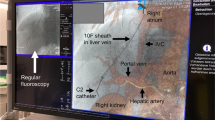Abstract.
The aim of this study was to evaluate the healing response to a new commercially available ePTFE-covered stent graft used to create transjugular intrahepatic portosystemic shunts (TIPS) in an animal model with and without intraluminal irradiation. The study was designed for ten domestic normotensive pigs. The TIPS was created using a ePTFE-covered stent graft (Viatorr, Gore, Flagstaff, Ariz.). Five animals were scheduled for intraluminal irradiation with iridium 192 immediately after TIPS creation with a dosage of 18 Gy. Shunt venograms were performed every 2 weeks. Animals from the irradiated and non-irradiated group were killed at 2-week intervals. Maximum follow-up was planned for 8 weeks in each group, with two animals in reserve. Gross specimen evaluation and histological examination, including scanning electron microscopy, was performed. Two animals died from interventional complications. In the irradiation group, one shunt occlusion and one stenosis occurred after 2 weeks. The stenosis regressed until the end of the 8-week follow-up period and probably was caused by a resolving thrombus. In the non-irradiated group, no shunt dysfunction was observed. One animal died early due to encephalopathy. Histology revealed an increased inflammatory reaction in the irradiation group, a lesser degree of incorporation of the stent graft, and a lesser degree of endothelialization of the inner surface compared with the non-irradiated group. No significant foreign body reaction was found at any time in any of the animals. The Viatorr stent graft was well tolerated in the pig model. Intraluminal irradiation seemed to have an adverse effect on the healing response. The TIPS patency was prolonged in both the irradiated and non-irradiated group compared with data from the literature; however, seemingly better results were observed in the non-irradiated group.






Similar content being viewed by others
References
LaBerge JM, Ring ES, Gordon RL et al. (1993) Creation of transjugular intrahepatic portosystemic shunts with the wallstent endoprosthesis: results in 100 patients. Radiology 187:413–420
Rossle M, Haag K, Oches A et al. (1994) The transjugular intrahepatic portosystemic stent-shunt procedure for variceal bleeding. N Engl J Med 330:165–171
Coldwell DM, Ring EJ, Rees CR, Zemel G, Darcy MD, Haskal ZJ, McKusick MA, Greenfield AJ (1995) Multicenter investigation of the role of transjugular intrahepatic portosystemic shunt in management of portal hypertension. Radiology 196:335–340
Hausegger KA, Sternthal HM, Klein GE, Karaic R, Stauber R, Zenker G (1994) Transjugular intrahepatic portosystemic shunt: angiographic follow-up and secondary interventions. Radiology 191:177–181
Nazarian GK, Ferral H, Castañeda-Zúñiga WR, Bjanrason H, Foshager MC, Rank JM, Anderson CA, Rengel GJ, Herman ME, Hunter DW (1994) Development of stenoses in transjugular intrahepatic portosystemic shunts. Radiology 192:231–234
Haskal ZJ, Pentecost MJ, Soulen MC, Shlansky-Goldberg RD, Baum RA, Cope C (1994) Transjugular intrahepatic protosystemic shunt stenosis and revision: early and midterm results. Am J Roentgenol 163:439–444
Ducoin H, El-Khoury J, Rousseau H, Barange K, Peron JM, Pierragi MR, Rumeau JL, Pascal JP, Vinel JP, Joffre F (1997) Histopathologic analysis of transjugular intrahepatic portosystemic shunts. Hepatology 25:1064–1069
LaBerge JM, Ferrell LD, Ring EJ et al. (1993) Histopathologic study of stenotic and occluded transjugular intrahepatic portosystemic shunts. J Vasc Intervent Radiol 4:779–786
Saxon RR, Medel-Hartvig J, Coreless CL et al. (1996) Bile duct injury as a major cause of stenosis and occlusion in transjugular intrahepatic portosystemic shunts: comparative histopathologic analysis of humans and swine. J Vasc Interv Radiol 7:487–497
Haskal ZJ, Davis A, McAllister A, Furth EE (1997) PTFE-encapsulate endovascular stent-graft for transjugular intrahepatic portosystemic shunts: experimental evaluation. Radiology 205:682–688
Haskal ZJ (1999) Improved patency of transjugular intrahepatic portosystemic shunts in humans: creation and revision with PTFE stent-grafts. Radiology 213:759–766
Nishime K, Saxon RR, Kichikawa K, Mendel-Hartvig J, Timmermans HA, Shim HJ, Uchida BT, Barton RE, Keller FS, Rösch J (1995) Improved transjugular intrahepatic portosystemic shunt patency with ePTFE-covered stent-grafts: experimental results in swine. Radiology 196:341–347
Jalan R, Forrest EH, Redhead DN, Hayes PC (1996) Transjugular intrahepatic portosystemic stent shunt (TIPSS) occlusion and the role biliary venous fistulae. J Hepatol 24:169–176
Haskal ZJ (2000) Transjugular intrahepatic shunt stenosis and thrombosis: shunt biology and stent-grafts. In: Rossi P, Ricci P, Broglia L (eds) Portal hypertension. Medical radiology/diagnostic imaging. Springer, Berlin Heidelberg New York, pp 221–232
Sanyal AJ, Contos MJ, Yager D, Zhu YN, Willey A, Graham MF (1998) Development of pseudointima and stenosis after transjugular intrahepatic portosystemic shunts: characterization of cell phenotype and function. Hepatology 28:22–32
Sauer P, Theilmann L, Herrmann S, Bruckner T, Roeren T, Richter G, Stremmel W et al. (1996) Phenprocoumon for prevention of shunt occlusion after transjugular portosystemic stent shunt (TIPS): a randomized trial. Hepatology 24:1433–1436
Schopohl B, Liermann D, Pohlit LJ, Heyd R, Strassmann G, Bauersachs R, Schulte-Huermann D, Rahl CG, Manegold KH, Kollath J, Bottcher HD (1996) 192-IR endovascular brachytherapy for avoidance of intimal hyperplasia after percutaneous transluminal angioplasty and stent implantation in peripheral vessels: 6 years of experience. Int J Radiat Oncol Biol Phys 1:835–840
Lessie T, Yoon HC, Nelson HA, Fillmore DJ, Baldwin GN, Miller FJ (1999) Intraluminal irradiation for TIPS stenosis: preliminary results in a swine model. J Vasc Interv Radiol 10:899–906
Otal P, Rousseau H, Vinel JP, Ducoin H, Hassissene S, Joffre F (1999) High occlusion rate in experimental transjugular intrahepatic portosystemic shunt created with a Dacron-covered nitinol stent. J Vasc Interv Radiol 10:183–188
Tanihata H, Saxon RR, Kubota Y, Pavcnik D, Uchida BT, Rosch J, Keller FS, Yamada R, Sato M (1997) Transjugular intrahepatic portosystemic shunt with silicone-covered Wallstents: results in a swine model. Radiology 205:181–184
Haskal ZJ, Brennecke LH (1999) Transjugular intrahepatic portosystemic shunts formed with polyethylene terephthalate-covered stents: experimental evaluation in pigs. Radiology 213:853–859
Haskal ZJ, Brennecke LJ (1999) Porous and nonporous polycarbonate urethane stent grafts for TIPS formation: biologic responses. J Vasc Interv Radiol 10:1255–1263
Author information
Authors and Affiliations
Corresponding author
Rights and permissions
About this article
Cite this article
Hausegger, K.A., Portugaller, H., Macri, N.P. et al. Covered stents in transjugular portosystemic shunt: healing response to non-porous ePTFE covered stent grafts with and without intraluminal irradiation. Eur Radiol 13, 1549–1558 (2003). https://doi.org/10.1007/s00330-002-1690-x
Received:
Revised:
Accepted:
Published:
Issue Date:
DOI: https://doi.org/10.1007/s00330-002-1690-x




